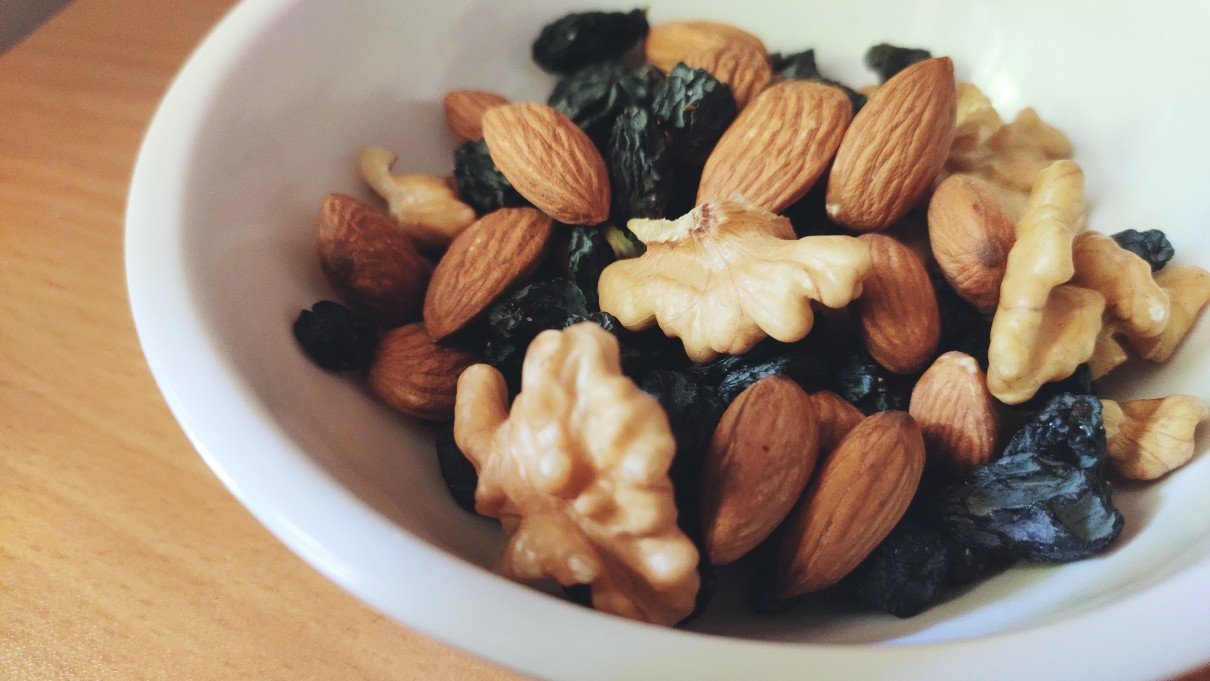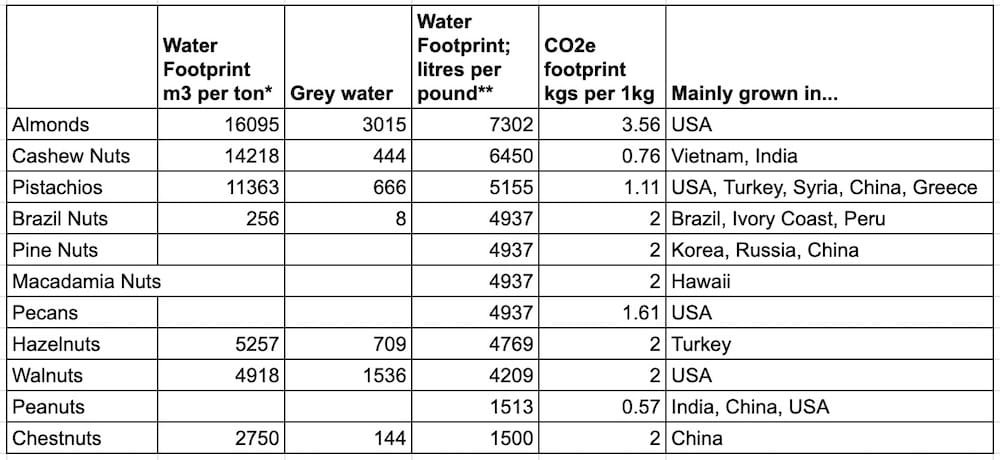Are All Nuts Bad for the Environment?

While nuts have less of an impact on the environment than meat and animal products, nuts are incredibly water-intensive. This means they use a lot of water during growth and production, especially in comparison to seeds.
Anyone who relies on nuts for protein (mostly found in animal products) might want to rethink buying just any type of nut.
It’s true that nuts can be bad for the environment, especially when grown in a drought-heavy state like California or processed by forced labor camps. But that doesn’t mean all nuts are bad for the environment!
The important thing is to buy Fair Trade products that are actually verified to be fair trade. Fair Trade certifications check to see if a product has safe working conditions, environmental protections, and sustainability, helping industries become more environmentally friendly.
Are nuts environmentally friendly?
One of the biggest factors in how environmentally friendly nuts are is their water footprint. Almonds, cashews, and pistachios take over 5000 liters of water per pound compared to chestnuts and peanuts taking less than 2000 liters.
Most nuts have been analyzed by the Water Footprint Network to determine their water footprint.
A water footprint measures the amount of water used during production, whether for individual goods or whole companies. Water consumption affects water shortages and pollution throughout the world. While some nuts, such as almonds and walnuts, are primarily grown in the USA, other nuts are imported across the world from other countries which can add stress to the source country’s water usage.
The Water Footprint Network gives almonds a global average water footprint total of 16095 m3 per ton, over double that of hazelnuts. Whereas Brazil nuts are given an average water footprint total of just 256 m3 per ton.
To be a sustainable food source, a nut should contribute to a healthy diet and be less environmentally damaging during production. Thanks to their water footprint, almonds are considered largely to be unsustainable, and other nuts aren’t far behind.
Why are almonds bad for the environment?
To grow one almond takes 1.1 gallons of water, while growing a pound of almonds takes around 1,900 gallons. They take far more water to produce than all other nuts, making almonds the most environmentally unfriendly type of nut.
Even so, almond milk generally uses less water per cup than cow’s milk (though this largely depends on the company producing the milk from either source).
California produces the majority of almonds, with a study from two Californian universities in 2017 noting that just one California almond averages 12 liters (or 3.2 gallons) in its water footprint. This is especially concerning due to California’s water issues, given water is so integral and vital to California.
That isn’t to say that almonds are the direct cause of California’s water troubles – alfalfa is said to use around 15% of the whole state’s irrigation water. Still, almonds drain around 10% of California’s water supply.
Since 82% of the world’s almonds are produced in California, this makes almond production environmentally unfriendly.
Even worse, 44% more land in California was used for almond farming in 2014 than it was in 2004. The California Department of Food and Agriculture reported in 2019 that there was a 10% increase between 2018 and 2019 in almond acreage, going from 1.39m to 1.53m acres.
The almond industry needs to undergo major changes to ensure that water usage and acreage don’t drastically affect California’s environment further. If you’re intent on buying almonds, look for fair trade and organic almonds at the very least!
Is cashew farming bad for the environment?
Over 1,700 gallons of water are needed to farm even one pound of cashew nuts. Their water footprint isn’t much smaller than almonds at 14,218 m3 per ton, though they use more “green water” (water from precipitation).
HEALabel, a conscious consumerism app, labels cashews as moderately sustainable and takes into consideration their impact on health, the environment, animals, and laborers for consumerism. On the environment, it notes the water footprint for cashews as high, carbon footprint as moderate, and destruction of the environment as low.
Cashews are primarily produced in Vietnam, India, and the Ivory Coast. Each has dangerous working conditions and low wages for workers in the industry.
Vietnam’s forced labor camps resulted in the term “blood cashews” due to their horrendous conditions. TIME reported on so-called labor therapy which included processing cashews in 2004. These workers would spend 6-10 hours husking and skinning nuts, burning their skin with cashew oil, for no or very little money.
India’s cashew industry employed around 500,000 workers without contracts or even gloves as they handled the caustic cashew oil. Nuts produced in the Ivory Coast are even sent to India and Vietnam for processing, utilizing the same poor working conditions for laborers.
Ultimately, cashew farming itself isn’t bad for the environment, but the processing of raw cashew nuts is weighed down heavily by the pain and exploitation of workers. Retailers who push down prices have been linked to the use of these processing units that encourage poverty-line wages and lack of protective equipment.
Buying Fair Trade-certified cashew nuts is the only way to avoid contributing to these dreadful conditions.
Are pistachios bad for the environment?
It takes 1,362 gallons of water to produce one pound of pistachios, and they have been given a global average water footprint of 11,363 m3 per ton. Like cashews, they are considered to be moderately sustainable, with a high water footprint, but they have a low carbon footprint and low environmental destruction.
Pistachios aren’t as bad for the environment as other nuts. Like almonds, they’re grown in California, but use less water and have a smaller carbon footprint – almonds have a CO2 equivalent footprint of 3.56 kgs per 1 kg against pistachio’s 1.11 kgs of CO2 per 1 kg.
Are any nuts environmentally friendly?
So now we know that most nuts have some kind of environmental impact, primarily through their water footprint or CO2 equivalent footprint, the question has to be asked: are any nuts actually environmentally friendly?
That depends on what you’re comparing it to.
Because nuts are such a good and healthy source of protein, we shouldn’t rush to cut them out. Avoiding the most unsustainable nuts and buying certified Fair Trade and Organic nuts is the best and simplest route to go for.
Buying locally sourced nuts is an extra step from there – if you live in the USA, the import emissions for walnuts, pecans, and pistachios will be lower for somebody who lives in the EU.

This handy table from Green Eco Friend lays out the environmental impacts of different nuts based on data collected in 2021. Based on these, chestnuts, walnuts, hazelnuts, and brazil nuts have the most data that suggests they’re more environmentally friendly than the three “big bads” of almonds, cashews, and pistachios.
Overall, even if you’re buying almonds, just be mindful of who you’re buying it from.
Look for certifications and labels like Fairtrade, Fair Trade Certified, Non-GMO Verified, Rainforest Alliance, and more. Certifications have certain standards they check for, whereas just labeling a pack of nuts “natural” or “pesticide free” isn’t verified.

